Newcastle Civic Centre (opposite this pub) is a grade II listed building, officially opened by King Olav V of Norway in 1968. The central lawn in the Quadrangle is open to the public and contains a fine bronze sculpture by David Wynne of Swans in Flight. The Five Swans rising from the pool of water ‘reflect the city’s long-established links with Scandinavia’. The five countries (Denmark, Sweden, Finland, Norway and Iceland) are each represented by a wild swan.
A photograph, illustration and text about Sir Charles Algernon Parsons.
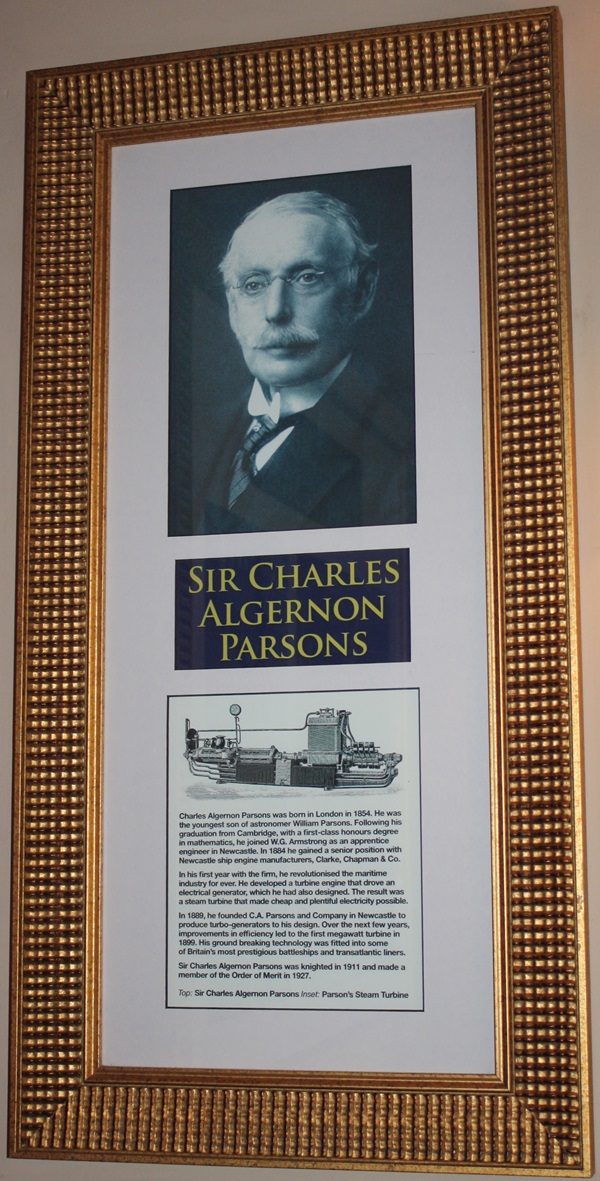
The text reads: Charles Algernon Parsons was born in London in 1854. He was the youngest son of astronomer William Parsons. Following his graduation from Cambridge, with a first-class honours degree in mathematics, he joined W.G. Armstrong as an apprentice engineer in Newcastle. In 1884 he gained a senior position with Newcastle ship engine manufacturers, Clarke, Chapman & Co.
In his first year with the firm, he revolutionised the maritime industry forever. He developed a turbine engine that drove an electrical generator, which he had also designed. The result was a steam turbine that made cheap and plentiful electricity possible.
In 1889, he founded C.A. Parsons and company in Newcastle to produce turbo-generators to his design. Over the next few years, improvement in efficiency led to the first megawatt turbine in 1899. His ground breaking technology was fitted into some of Britain’s most prestigious battleships and transatlantic liners.
Sir Charles Algernon Parsons was knighted in 1911 and made a member of the Order of Merit in 1927.
Top: Sir Charles Algernon Parsons
Inset: Parsons’s Steam Turbine.
Illustrations and text about Matthew Murray.
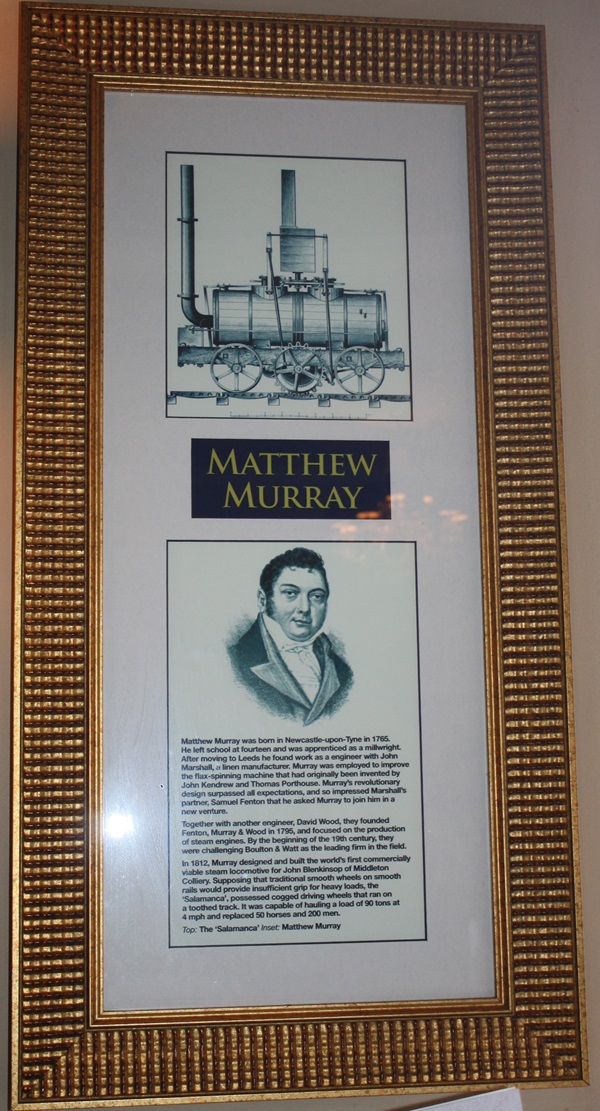
The text reads: Matthew Murray was born in Newcastle-upon-Tyne in 1765. He left school at fourteen and was apprenticed as a millwright. After moving to Leeds he found work as an engineer with John Marshall, a linen manufacturer. Murray was employed to improve the flax-spinning machine that had originally been invented by John Kendrew and Thomas Porthouse. Murray’s revolutionary design surpassed all expectations, and so impressed Marshall’s partner, Samuel Fenton that he asked Murray to join him in a new venture.
Together with another engineer, David Wood, they founded Fenton, Murray & Wood in 1795, and focused on the production of steam engines. By the beginning of the 19th century, they were challenging Boulton & Watt as the leading firm in the field.
In 1812, Murray designed and built the world’s first commercially visible steam locomotive for John Blenkinsop of Middleton Colliery. Supposing that traditional smooth wheels on smooth rails would provide insufficient grip for heavy loads, the ‘Salamanca’, possessed cogged driving wheels that ran on a toothed track. It was capable of hauling a load of 90 tons at 4 mph and replaced 50 horses and 200 men.
Top: The ‘Salamanca’
Inset: Matthew Murray.
A photograph, illustration and text about Paddy’s Market.
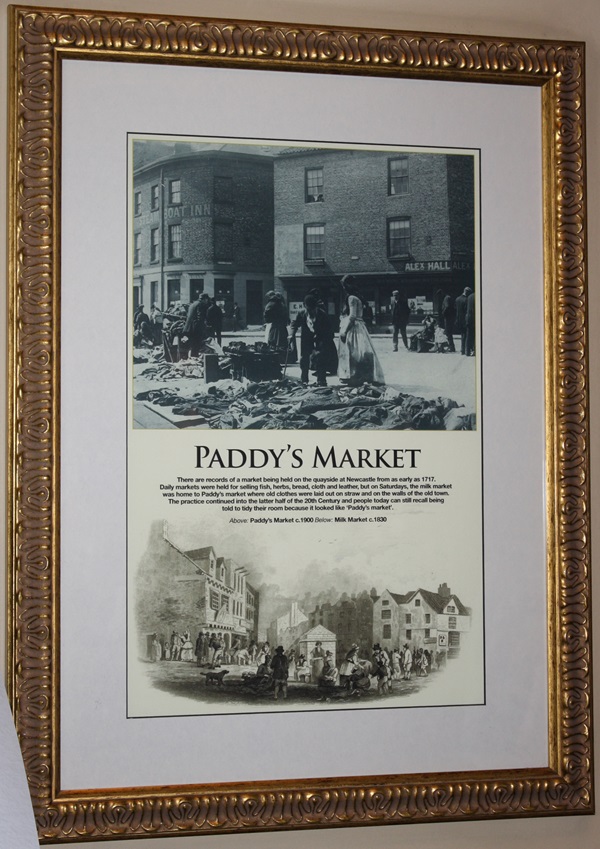
The text reads: There are records of a market being held on the quayside at Newcastle from as early as 1717. Daily markets were held for selling fish, herbs, bread, cloth and leather, but on Saturdays, the milk market was home to Paddy’s market where old clothes were laid out on straw and on the walls of the old town. The practice continues into the latter half of the 20th Century and people today can still recall being told to tidy their room because it looked like ‘Paddy’s market’
Above: Paddy’s Market c.1900
Below: Milk Market c.1830.
An illustration of the viaduct, at the end of Dean Street.
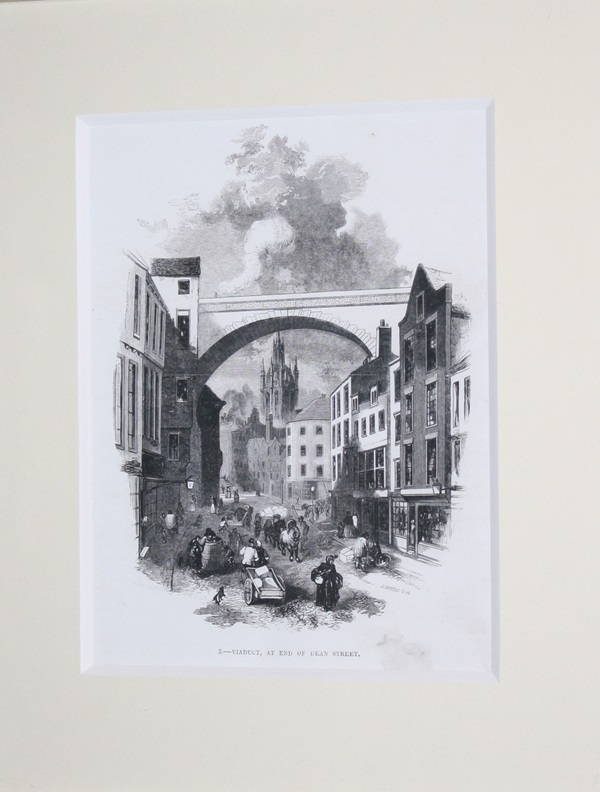
An illustration of St. Nicholas, from head of the side.
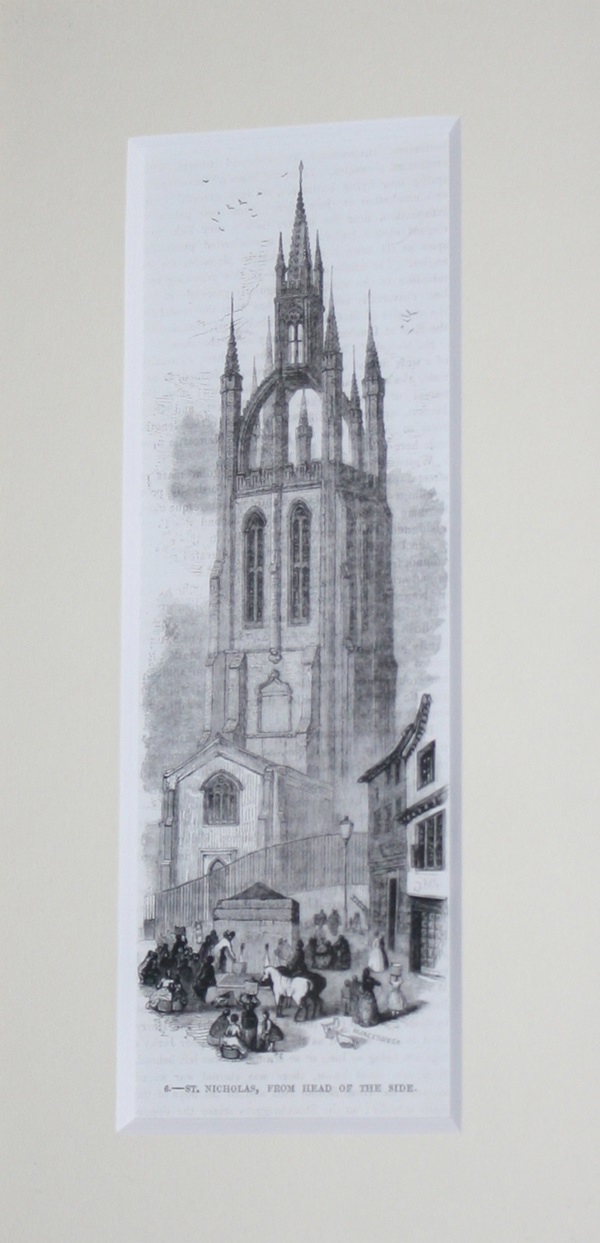
Prints and text about Lord Collingwood.
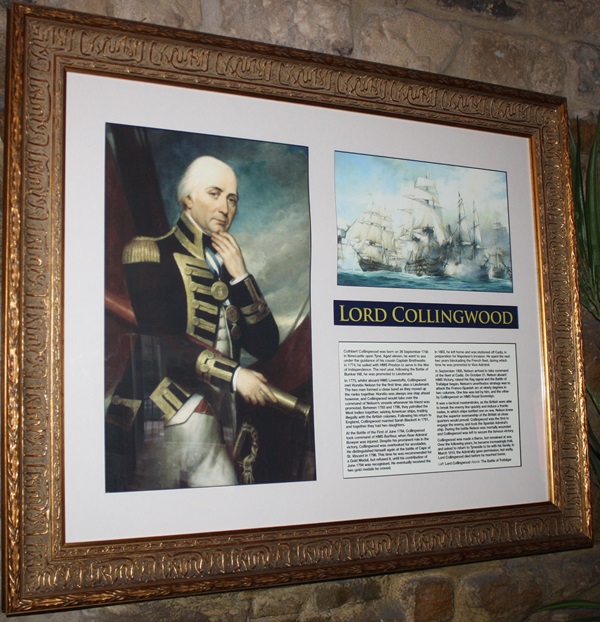
The text reads: Cuthbert Collingwood was born on 26 September 1748 in Newcastle upon Tyne. Aged eleven, he went to sea under the guidance of his cousin Captain Brathwaite. In 1774, he sailed with HMS Preston to serve in the War of Independence. The next year, following the Battle of Bunker Hill, he was promoted to Lieutenant.
In 1775, whilst aboard HMS Lowestoffe, Collingwood met Horatio Nelson for the first time, also a Lieutenant. The two men formed a close bond as they moved up the ranks together. Horatio was always one step ahead however, and Collingwood would take over the command of Nelson’s vessels whenever his friend was promoted. Between 1783 and 1786, they patrolled the West Indies together, seizing American ships, trading illegally with the British colonies. Following his return to England, Collingwood married Sarah Blackett in 1791, and together they had two daughters.
At the battle of the First of June 1794, Collingwood took command of HMS Barfleur, when Rear-Admiral Bowyer was injured. Despite his prominent role in victory, Collingwood was over looked for accolades. He distinguished himself again at the battle of Cape of St. Vincent in 1796. This time he was recommended for a Gold Medal, but refused it, until his contribution of June 1794 was recognised. He eventually received the two gold medals he craved.
In 1803, he left home and was stationed off Cadiz, in preparation for Napoleon’s invasion. He spent the next two years blockading the French fleet, during which time he was promoted to Vice-Admiral.
In September 1805, Nelson arrived to take command of the fleet at Cadiz. On October 21, Nelson aboard HMS Victory, raised his flag signal and the Battle of Trafalgar began. Nelson’s unorthodox strategy was to attack the Franco-Spanish arc at ninety degrees in two columns. One line was led by him, and the other by Collingwood on HMS Royal Sovereign.
It was a tactical masterstroke, as the British were able to break the enemy line quickly and induce a frantic melee, in which ships battled one on one. Nelson knew that the superior seamanship of the British at close quarters would prevail. Collingwood was the first to engage the enemy, and took the Spanish Admiral’s ship. During the battle Nelson was mortally wounded and Collingwood was left to secure the famous victory.
Collingwood was made a Baron, but remained at sea. Over the following years, he became increasingly frail, and asked to return to Tyneside to be with his family. In March 1810, the Admiralty gave permission, but sadly, Lord Collingwood died before he reached home.
Left: Lord Collingwood
Above: The Battle of Trafalgar.
Photographs and text about Hadrian’s Wall.
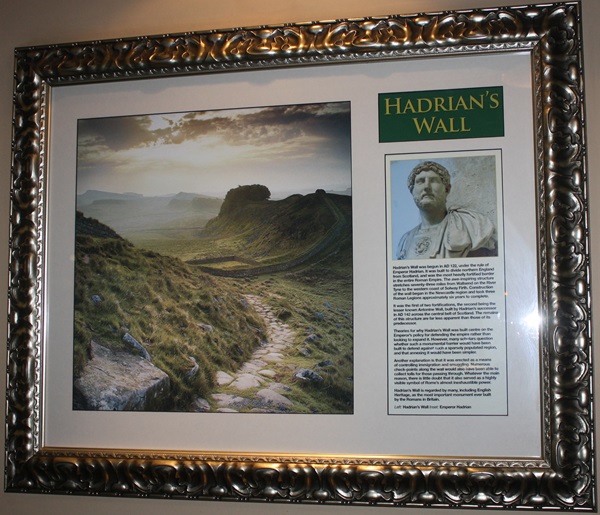
The text reads: Hadrian’s Wall was begun in AD 122, under the rule of Emperor Hadrian. It was built to divide northern England from Scotland, and was the most heavily fortified border in the entire Roman Empire. The awe-inspiring structure stretches seventy-three miles from Wallsend on the River Tyne to the western coast of Solway Firth. Construction of the wall began in the Newcastle region and took three Roman Legions approximately six years to complete.
It was the first of two fortifications, the second being the lesser known Antonine Wall, built by Hadrian’s successor in AD 142 across the central belt of Scotland. The remains of their structure are far less apparent than those of its predecessor.
Theories for why Hadrian’s Wall was built centre on the Emperor’s policy for defending the empire rather than looking to expand it. However, many scholars question whether such a monumental barrier would have been built to defend against such a sparsely populated region, and that annexing it would have been simpler.
Another explanation is that it was erected as a means of controlling immigration and smuggling. Numerous check-points along the wall would also have been able to collect tolls for those passing through. Whatever the main reason, there is little doubt that it was also served as a highly visible symbol of Rome’s almost inexhaustible power.
Hadrian’s Wall is regarded by many, including English Heritage, as the most important monument ever built by the Romans in Britain.
Left: Hadrian’s Wall
Inset: Emperor Hadrian.
An illustration and text about the Royal Arcade.
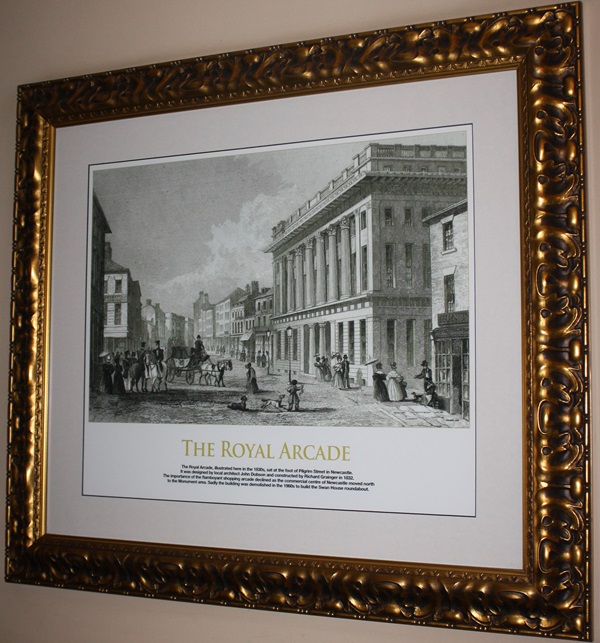
The text reads: The Royal Arcade, illustrated here in the 1830’s, sat at the foot of Pilgrim Street in Newcastle. It was designed by local architect John Dobson and constructed by Richard Grainger in 1832. The importance of the flamboyant shopping arcade declined as the commercial centre of Newcastle moved north of the Monument area, Sadly the building was demolished in the 1960s to build the Swan House roundabout.
An illustration and text about Charles Hutton.

The text reads: Charles Hutton was born on 14 August 1737 in Newcastle. When he was seven years old he was involved in a fight with some boys, and his elbow was dislocated. Ashamed, he hid his injury from his parents for so long, that by the time he revealed it, he was left with a permanent disability. The incapacity meant he was unable to follow his father, and work at the colliery. Instead his parents sent him to school to learn how to read and write. In time he became the schoolmaster, and taught amongst others John Scott, who became Lord High Chancellor of England.
Throughout his life he published many notable works, beginning in 1764 with ‘The Schoolmasters Guide, or a Complete System of Practical Arithmetic’. In 1773, he was appointed Professor of Mathematics at the Royal Military Academy at Woolwich. The following year, he became a Fellow of the Royal Society and later received an honorary degree from the University of Edinburgh.
In 1786, Hutton began to suffer from a lung disorder, and decided to move from his damp home near the river to a hillside location. He built a house for himself and several more for letting. Almost immediately, George III decided to move The Royal Military Academy to the same location, and offered Hutton a huge recompense to relocate. Hutton therefore became a successful mathematician through injury and a very wealthy man through illness.
Photographs and text about Swan Hunter.
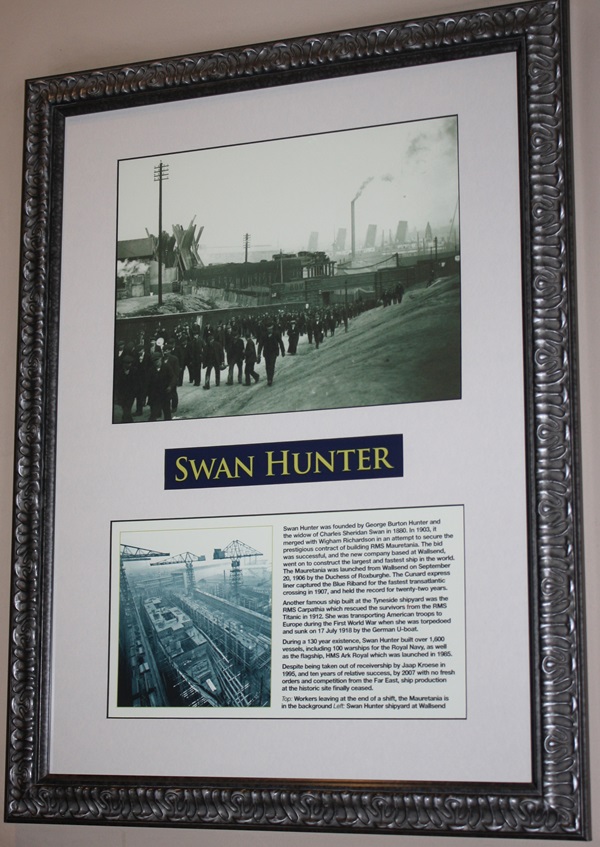
The text reads: Swan Hunter was founded by George Burton Hunter and the widow of Charles Sheridan Swan in 1880. In 1903, it merged with Wigham Richardson in an attempt to secure the prestigious contract of building RMS Mauretania. The bid was successful, and the new company based in Wallsend, went on to construct the largest and fastest ship in the world. The Mauretania was launched from Wallsend on September 20, 1906 by the Duchess of Roxburghe. The Cunard express liner captured the Blue Riband for the fastest transatlantic crossing in 1907, and held the record for twenty-two years.
Another famous ship built at the Tyneside shipyard was the RMS Carpathia which rescued the survivors from the RMS Titanic in 1912. She was transporting American troops to Europe during the First World War when she was torpedoed and sunk on 17 July 1918 by the German U-boat.
During a 130 year existence, Swan Hunter built over 1,600 vessels, including 100 warships for the Royal Navy, as well as the flagship, HMS Ark Royal which was launched in 1985.
Despite being taken out of receivership by Jaap Kroese in 1995, and ten years of relative success, by 2007 with no fresh orders and competition from the Far East, ship production at the historic site finally ceased.
Top: Workers leaving at the end of a shift, the Mauretania is in the background
Left: Swan Hunter shipyard at Wallsend.
Photographs and text about Newcastle Brown Ale.
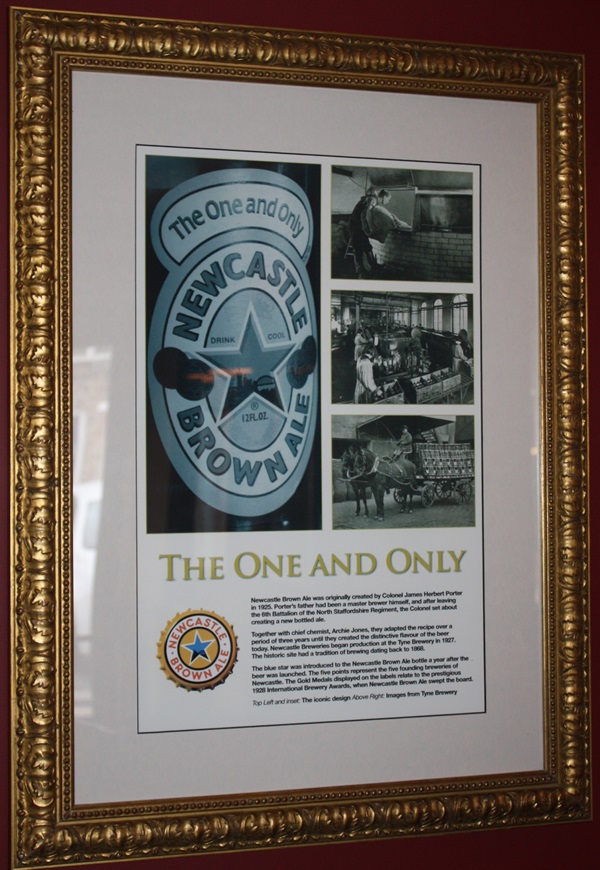
The text reads: Newcastle Brown Ale was originally created by Colonel James Herbert Porter in 1925. Porter’s father had been a master brewer himself, and after leaving the 6th Battalion of the North Staffordshire Regiment, the Colonel set about creating new bottled ale.
Together with chief chemist, Archie Jones, they adapted the recipe over a period of three years until they created the distinctive flavour of the beer today. Newcastle Breweries began production at the Tyne Brewery in 1927. The historic site had a tradition of brewing dating back to 1868.
The blue star was introduced to the Newcastle Brown Ale bottle a year after the beer was launched. The five points represent the five founding breweries of Newcastle. The Gold Medals displayed on the labels relate to the prestigious 1928 International Brewery Awards, when Newcastle Brown Ale swept the board.
Top Left and inset: The iconic design
Above Right: Images from Tyne Brewery.
A photograph and text about Basil Bunting.
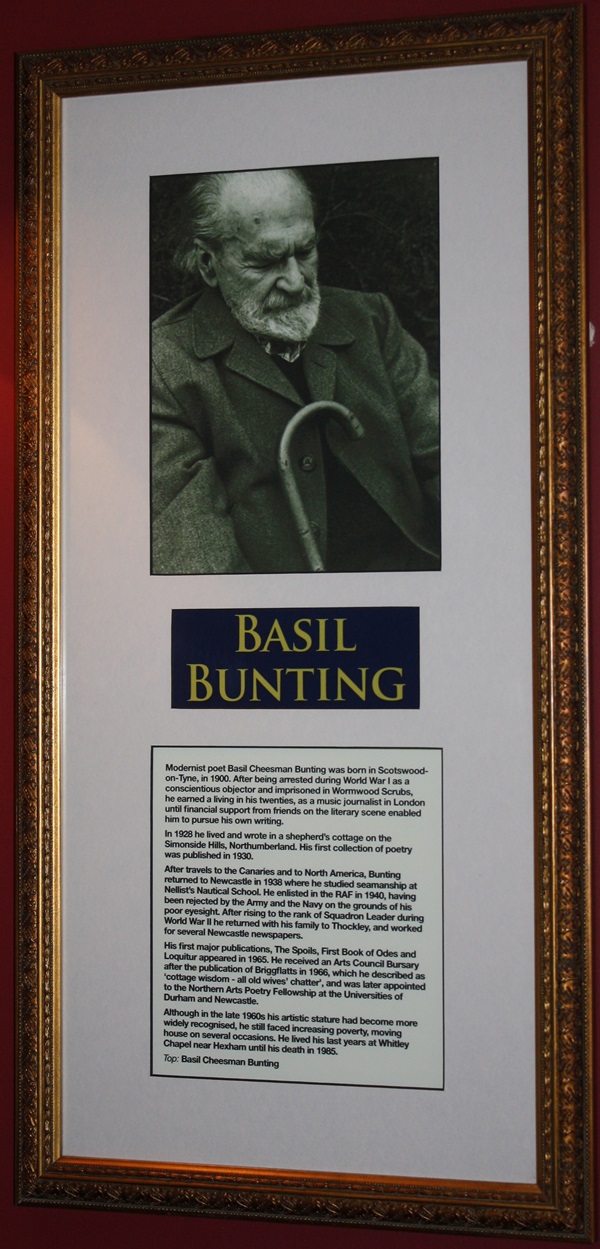
The text reads: Modernist poet Basil Cheesman Bunting was born in Scotswood-on-Tyne, in 1990. After being arrested during World War I as a conscientious objector and imprisoned in Wormwood Scrubs, he earned a living in his twenties, as a music journalist in London until financial support from friends on the literary scene enabled him to pursue his own writing.
In 1928, he lived and wrote in a shepherd’s cottage on the Simonside Hills, Northumberland. His first collection of poetry was published in 1930.
After travels to the Canaries and to North America, Bunting returned to Newcastle in 1938 where he studied seamanship at Nellist’s Nautical School. He enlisted in the RAF in 1940, having been rejected by the Army and the Navy on the grounds of his poor eyesight. After rising to the rank of Squadron Leader during World War II he returned with his family to Thockley, and worked for several Newcastle newspapers.
His first major publications, The Spoils, First Book of Odes and Loquitur appeared in 1965. He received an Arts Council Bursary after the publication of Briggflatts in 1966, which he described as ‘cottage wisdom – all old wives’ chatter’, and was later appointed to the Northern Arts Poetry Fellowship at the Universities of Durham and Newcastle.
Although in the late 1960s his artistic stature had become more widely recognised, he still faced increasing poverty, moving house on several occasions. He lives his last years at Whitley Chapel near Hexham until his death in 1985.
Top: Basil Cheesman Bunting.
Photographs, illustration and text about Ringtons Tea.
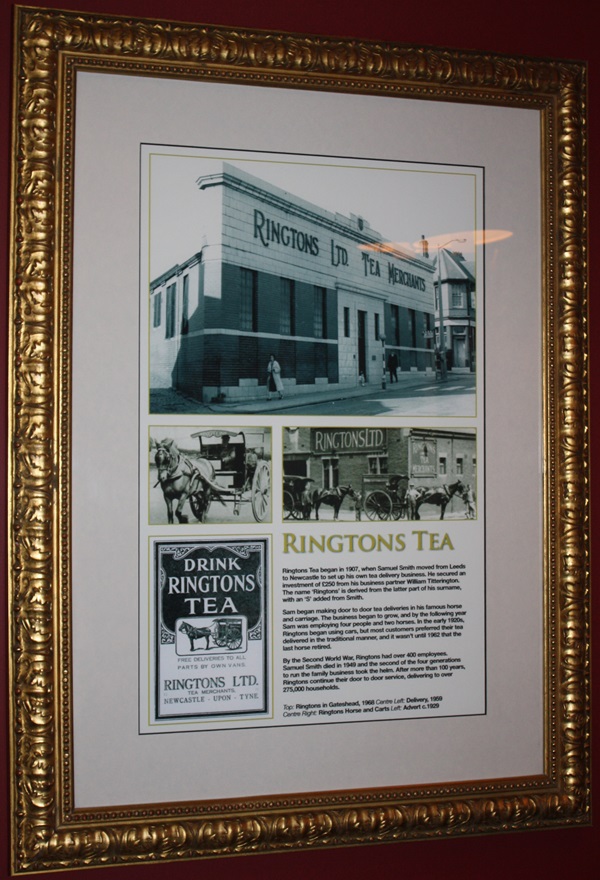
The text reads: Ringtons Tea began in 1907, when Samuel Smith moved from Leeds to Newcastle to set up his own tea delivery business. He secured an investment of £250 from his business partner William Titterington. The name ‘Ringtons’ is derived from the latter part of his surname. With an ‘S’ added from the Smith.
Sam began making door to door tea delivered in his famous horse and carriage. The business began to grow, and by the following year Sam was employing four people and two horses. In the early 1920s, Ringtons began using cars, but most customers preferred their tea delivered in the traditional manner, and it wasn’t until 1962 that the last horse retired.
By the Second World War, Ringtons had over 400 employees. Samuel Smith died in 1949 and the second of the four generations to run the family business took the helm. After more than 100 years, Ringtons continue their door to door service, delivering to over 270,000 households.
Top: Ringtons in Gateshead 1968
Centre Left: Delivery, 1959
Centre Right: Ringtons Horse and Carts
Left: Advert c.1929.
Photographs and text about Tyne Bridge.
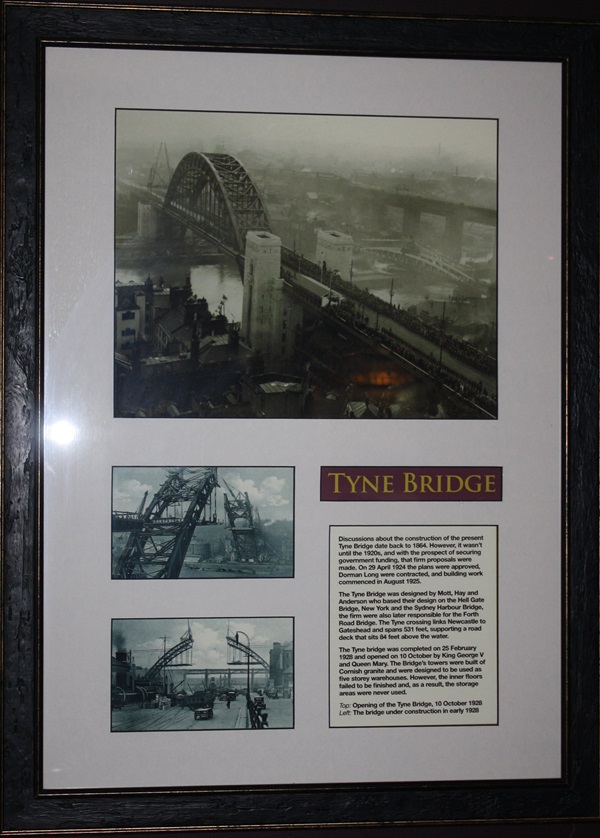
The text reads: Discussions about the construction of the present Tyne Bridge date back to 1864. However, it wasn’t until the 1920s, and with the prospect of securing government funding, that firm proposals were made. On 29 April 1924 the plans were approved, Dorman Long were contracted, and the building work commenced in August 1925.
The Tyne Bridge was designed by Mott, Hay and Anderson who based their design on the Hell Gate Bridge, New York and the Sydney Harbour Bridge, the firm were also later responsible for the Forth Road Bridge. The Tyne crossing links Newcastle to Gateshead and spans 531 feet, supporting a road deck that suits 84 feet above the water.
The Tyne bridge was completed on 25 February 1928 and opened on 10 October by King George V and Queen Mary. The bridge’s towers were built of Cornish granite and were designed to be used as five storey warehouses. However, the inner floors failed to be finished and, as a result, the storage areas were never used.
Top: Opening of the Tyne Bridge, 10 October 1928
Left: The bridge under construction in early 1928.
A photograph and text about Arthur Stewardson – local chemist.
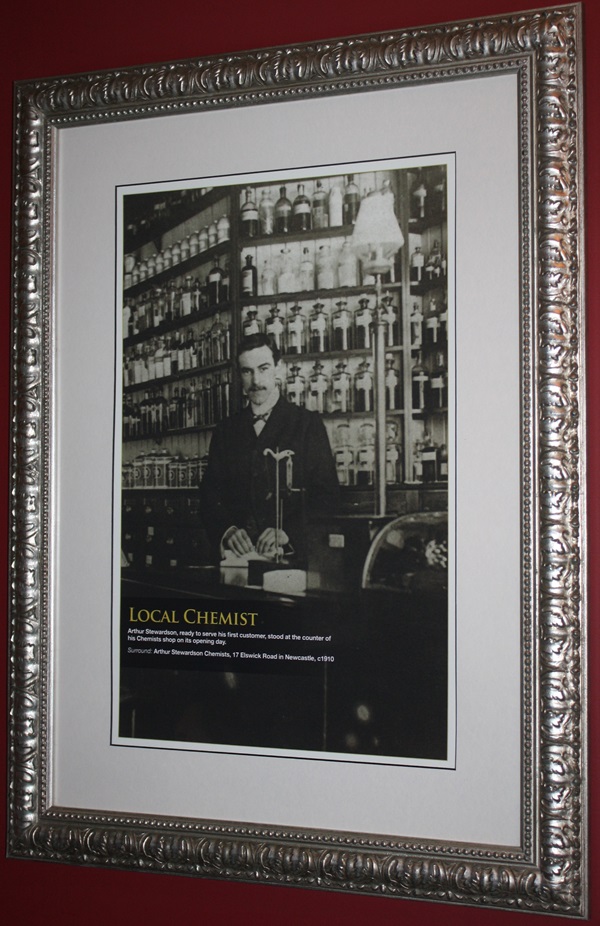
The text reads: Arthur Stewardson, ready to serve his first customer, stood at the counter of his Chemists shop on its opening day.
Surround: Arthur Stewardson Chemists, 17 Elswick Road in Newcastle, c1910.
A photograph and text about Sandgate, Newcastle.
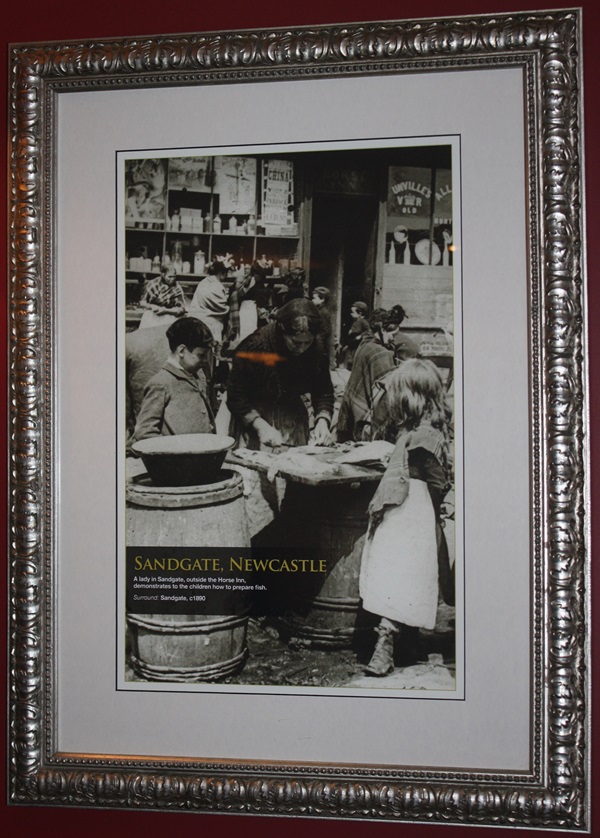
The text reads: A lady in Sandgate, outside the Horse Inn, demonstrates to the children how to prepare fish.
Surround: Sandgate, c1890.
A photograph, illustration and text about Grainger Town.
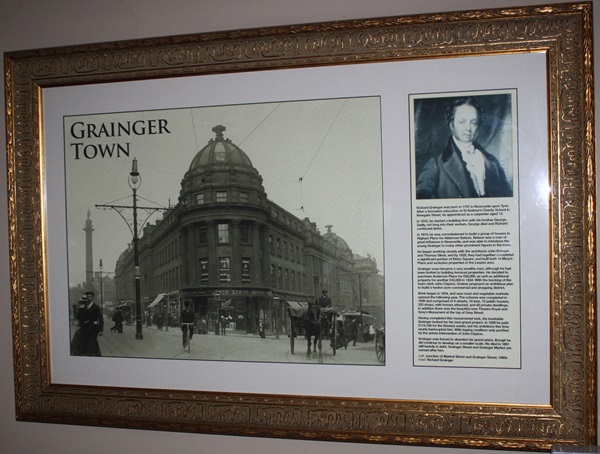
The text reads: Richard Grainger was born 1797 in Newcastle upon Tyne. After a formative education at St Andrew’s Charity School in Newgate Street, he apprenticed as a carpenter aged 12.
In 1819, he was commissioned to a build a group of houses in Higham Place for Alderman Batson. Batson was a man of great influence in Newcastle, and was able to introduce the young Grainger to many other prominent figures in the town.
He began working closely with the architects John Dobson and Thomas Oliver, and by 1829, they had together completed a significant portion of Eldon Square, and build both St Mary’s place and exclusive properties in the Leazes area.
Grainger soon became a very wealthy man, although he had been limited to building terraced properties. He decided to purchase Anderson Place for £50,000, as well as an additional property for another £45,000 in 1834. With the backing of the town clerk John Clayton, Grainger proposed an ambitious plan to build a twelve-acre commercial and shopping district.
Work began in 1834, and new meat and vegetable markets opened the following year. The scheme was completed in 1839 and comprised of 9 streets, 10 inns, 12 public houses, 325 shops, with homes attached, and 40 private dwellings. In addition there was the beautiful new Theatre Royal and Grey’s Monument at the top of Grey Street.
Having completed this monumental task the insatiable Grainger looked for his next grand project. In 1839 he paid £114,100 for the Elswick estate, but his ambitions this time nearly bankrupted him. With baying creditors only pacified by the astute intervention of John Clayton.
Grainger was forced to abandon his grand plans, though he did continue to develop on a smaller scale. He died in 1861 still heavily in dept. Grainger Street and Grainger Market are named after him.
Left: Junction of Market Street and Grainger Street, 1900s
Inset: Richard Grainger.
A photograph and text about Cullercoats fishermen.
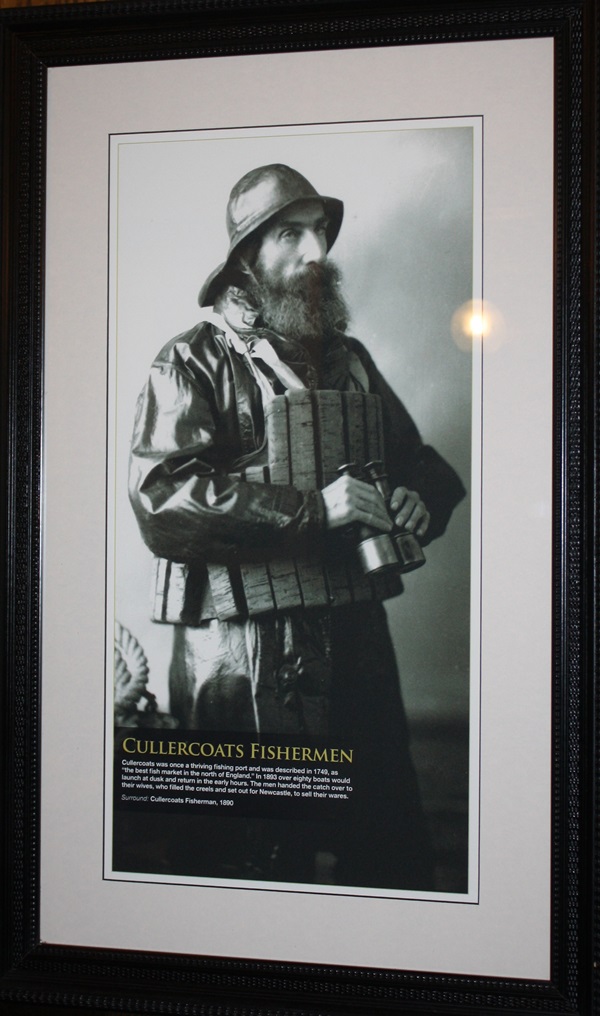
The text reads: Cullercoats was once a thriving fishing port and was described in 1749, as “the best fish market in the north of England.” In 1893 over eighty boats would launch at dusk and return in the early hours. The men handed the catch over to their wives, who filled the creels and set out for Newcastle, to sell their wares.
Surround: Cullercoats Fisherman, 1890.
Photographs and text about Bill Travers.
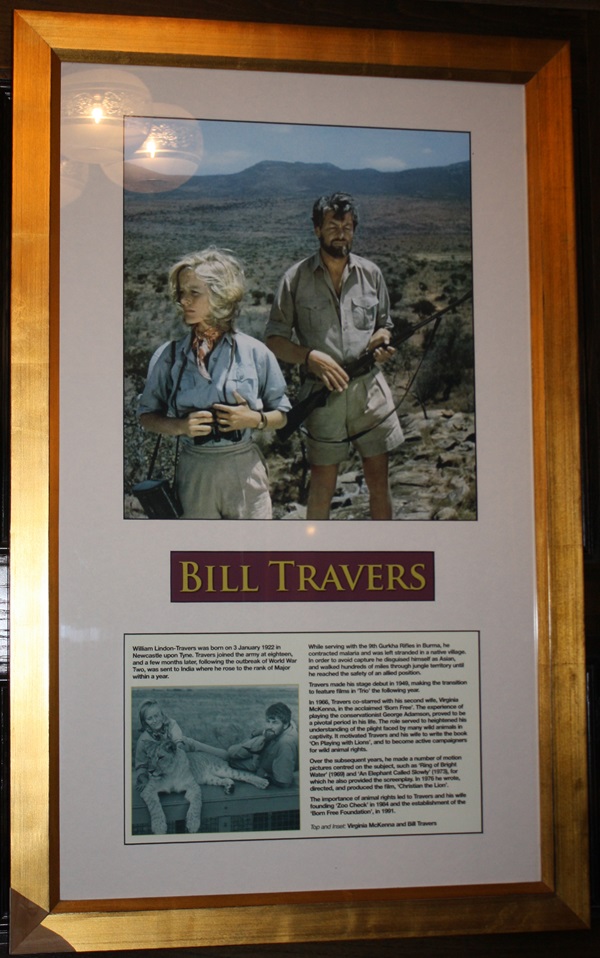
The text reads: William Lindon-Travers was born on 3 January 1922 in Newcastle upon Tyne. Travers joined the army at eighteen, and a few months later, following the outbreak of World War Two, was sent to India where he rose to the rank of Major within a year.
While serving with the 9th Gurkha Rifles in Burma, he contracted malaria and was left stranded in a native village. In order to avoid capture he disguised himself as Asian, and walked hundreds of miles through jungle territory until he reached the safety of an allied position.
Travers made his stage debut in 1949, making the transition to feature films in ‘Trio’ the following year.
In 1966, Travers co-starred with his second wife, Virginia McKenna, in the acclaimed ‘Born-Free’. The experience of playing the conservationist George Adamson, proved to be a pivotal period in his life. The role served to heighten his understanding of the plight faced by many wild animals in captivity. It motivated Travers and his wife to write the book ‘On Playing with Lions’, and to become active campaigners for wild animal fights.
Over the subsequent years, he made a number of motion pictures centred on the subject, such as ‘Ring of Bright Water’ (1969) and ‘An Elephant Called Slowly’ (1973), for which he also provided the screenplay. In 1976 he wrote, directed, and produced the film, ‘Christian the Lion’.
The importance of animal rights led to Travers and his wife founding ‘Zoo Check’ in 1964 and the established of the ‘Born Free Foundation’, in 1991.
Top and Inset: Virginia McKenna and Bill Travers.
Photographs and text about Vilyam Fisher.
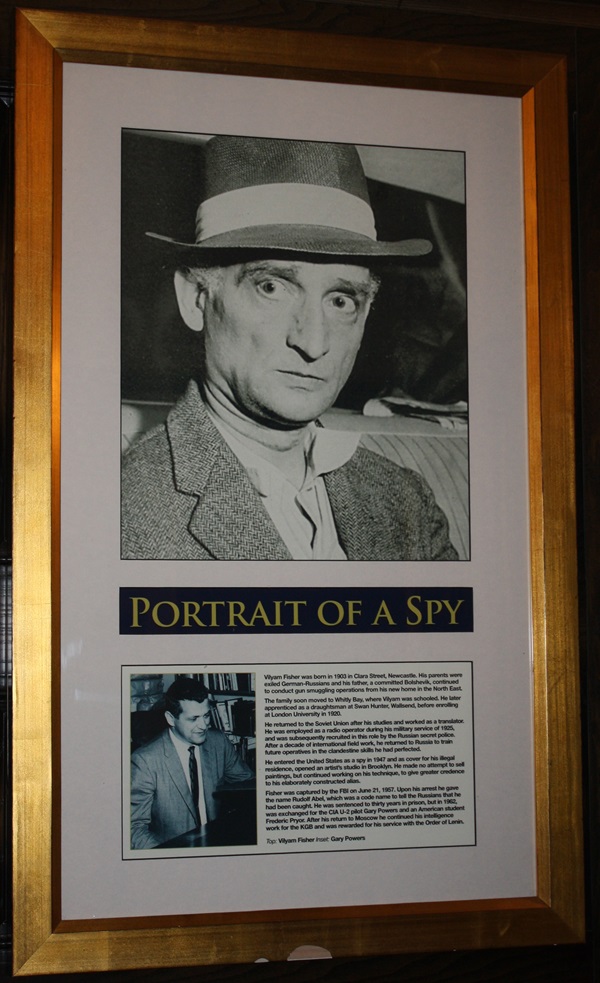
The text reads: Vilyam Fisher was born in 1903 in Clara Street, Newcastle. His parents were exiled German-Russians and his father, a committed Bolshevik, continued to conduct gun smuggling operations from his new home in the North East.
The family soon moved to Whitly Bay, where Vilyam was schooled. He later apprenticed as a draughtsman at Swan Hunter, Wallsend, before enrolling at London University in 1920.
He returned to the Soviet Union after his studies and worked as a translator. He was employed as a radio operator during his military service of 1925, and was subsequently recruited in this role by the Russian secret police. After a decade of international field work, he returned to Russia to train future operatives in the clandestine skills he has perfected.
He entered the United States as a spy in 1947 and as a cover for his illegal residence, opened an artist’s studio in Brooklyn. He made no attempt to sell paintings, but continued working on his technique, to give greater credence to his elaborately constructed alias.
Fisher was captured by the FBI on June 21, 1957. Upon his arrest he gave the name Rudolf Abel, which was a code name tell the Russians that he has been caught. He was sentenced to thirty years in prison, but in 1962, was exchanged for the CIA U-2 pilot Gary Powers and an American student Frederic Pryor. After his return to Moscow he continued his intelligence work for the KGB and was rewarded for his service with the Order of Lenin.
Top: Vilyam Fisher
Inset: Gary Powers.
Photographs and text about Mark Knopfler.
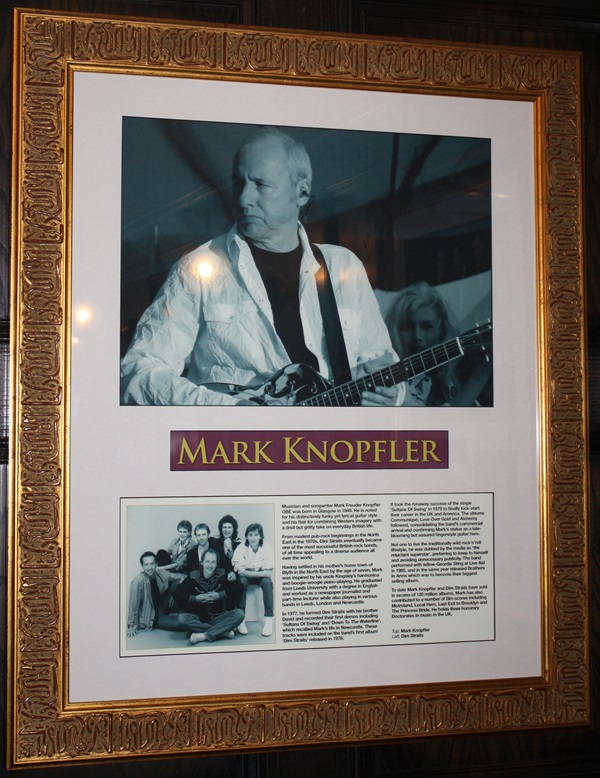
The text reads: Musician and songwriter Mark Freuder Knopfler OBE was born in Glasgow in 1949. He is noted for his distinctively funky yet lyrical guitar style and his flair for combining Western imagery with a droll but gritty take on everyday British life.
From modest pub-rock beginnings in the North East in the 1970s, Dire Straits eventually became one of the most successful British rock bands of all time, appealing to a diverse audience all over the world.
Having settled in his mother’s home town of Blyth in the North East by the age of seven, Mark was inspired by his uncle Kingsley’s harmonica and boogie-woogie piano-playing. He graduated from Leeds University with a degree in English and worked as a newspaper journalist and part-time lecturer while also playing in various bands in Leeds, London and Newcastle.
In 1977, he formed Dire Straits with his brother David and recorded their first demos including ‘Sultans Of Swing’ and ‘Down To The Waterline’, which recalled Mark’s life in Newcastle. These tracks were included on the band’s first album ‘Dire Straits’ released in 1978.
It took the runaway success of the single ‘Sultans Of Swing’ in 1979 to finally kick-start their career in the UK and America. The albums ‘Communiqué’, ‘Love Over Gold’ and ‘Alchemy’ followed, consolidating the band’s commercial arrival and confirming Mark’s status as a late-blooming but assured fingerstyle guitar hero.
Not one to live the traditionally wild rock ’n’ roll lifestyle, he was dubbed by the media as ‘the reluctant superstar’, preferring to keep to himself and avoiding unnecessary publicity. The band performed with fellow-Geordie Sting at Live Aid in 1985, and in the same year released ‘Brothers in Arms’ which was to become their biggest selling album.
To date Mark Knopfler and Dire Straits have sold in excess of 120 million albums. Mark has also contributed to a number of film scores including Metroland, Local Hero, Last Exit to Brooklyn and The Princess Bride. He holds three honorary Doctorates in music in the UK.
Top: Mark Knopfler
Left: Dire Straits.
Photographs and text about Butch Cassidy.
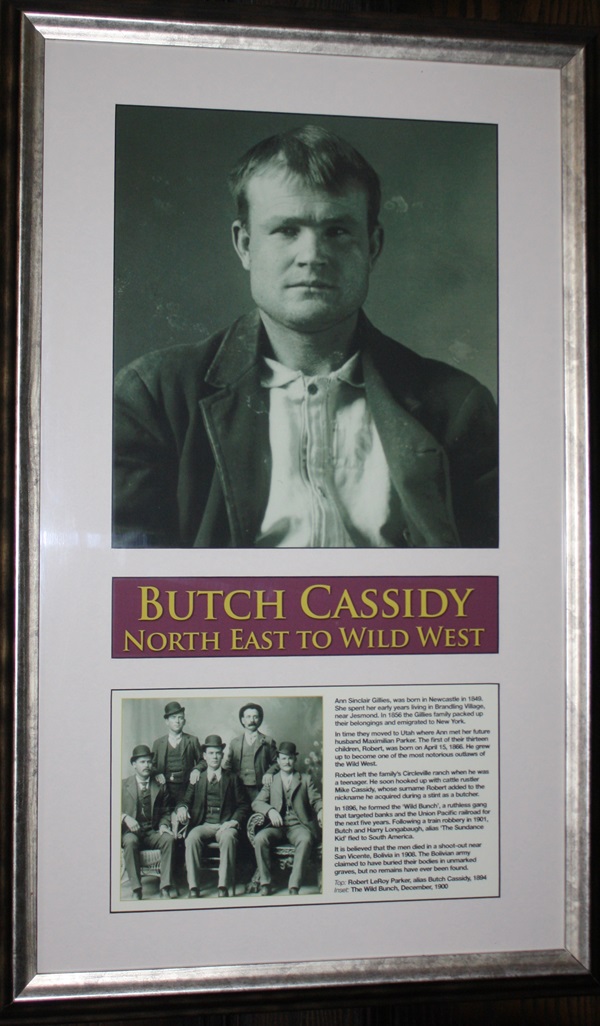
The text reads: Ann Sinclair Gillies, was born in Newcastle in 1849. She spent her early years living in Brandling Village, near Jesmond. In 1856 the Gillies family packed up their belongings and emigrated to New York.
In time they moved to Utah where Ann met her future husband Maximilian Parker. The first of their thirteen children, Robert, was born on April 15, 1866. He grew up to become one of the most notorious outlaws of the Wild West.
Robert left the family’s Circleville ranch when he was a teenager. He soon hooked up with cattle rustler Mike Cassidy, whose surname Robert added to the nickname he acquired during a stint as a butcher.
In 1896, he formed the ‘Wild Bunch’, a ruthless gang that targeted banks and the Union Pacific railroad for the next five years. Following a train robbery in 1901, Butch and Harry Longabaugh, alias ‘The Sundance Kid’ fled to South America.
It is believed that the men died in a shoot-out near San Vincente, Bolivia in 1908. The Bolivian army claimed to have buried their bodies in unmarked graves, but no remains have ever been found.
Top: Robert LeRoy Parker, alias Butch Cassidy, 1894
Inset: The Wild Bunch, December, 1900.
A photograph and text about Jesmond Dene.
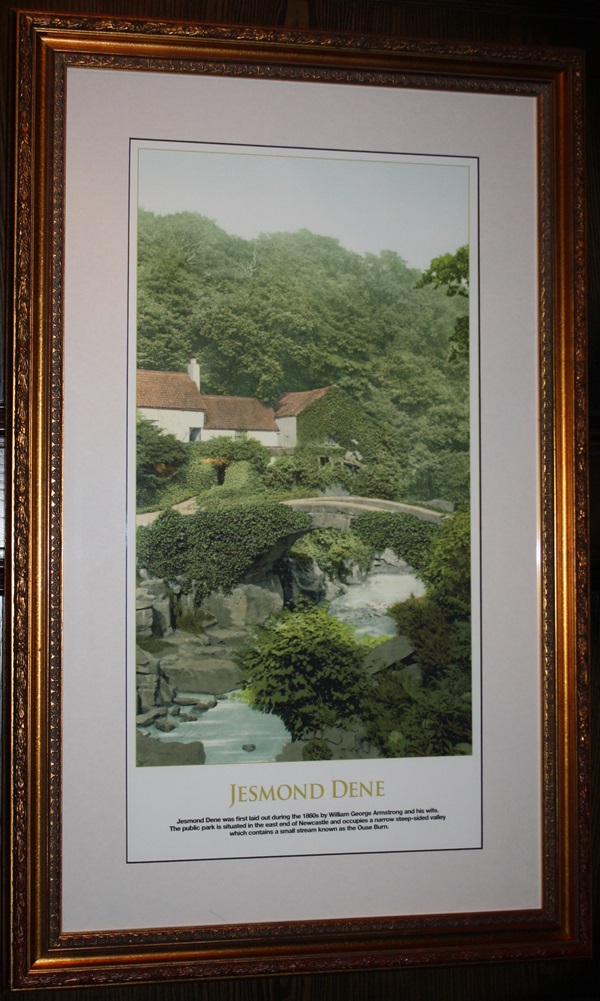
The text reads: Jesmond Dene was first laid out during the 1860s by William George Armstrong and his wife. The public park is situated in the east end of Newcastle and occupies a narrow steep-sided valley which contains a small stream, known as the Ouse Burn.
Illustrations and text about Andrew Liver Salts.
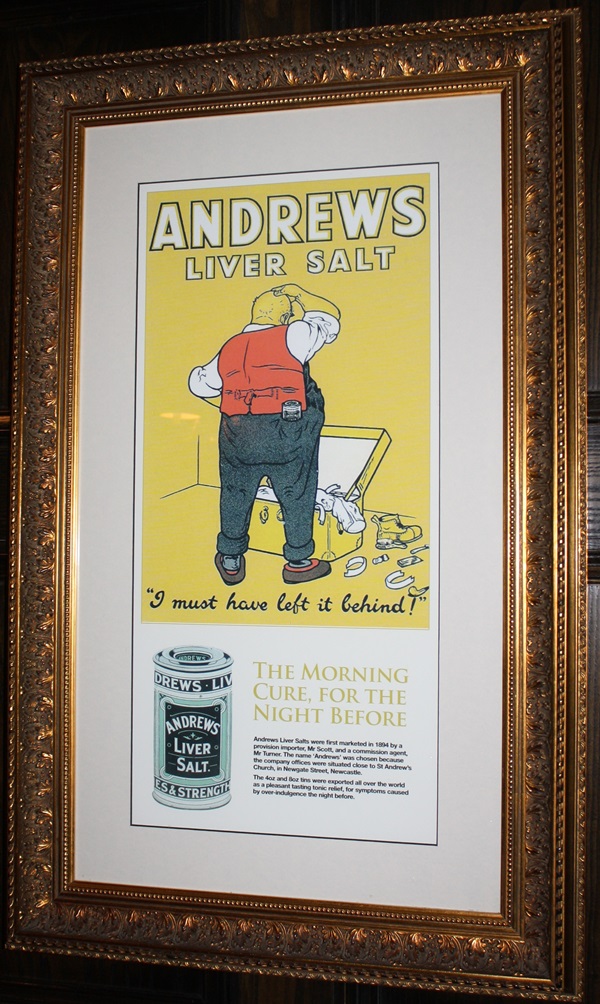
The text reads: Andrews Liver Salts were first marketed in 1894 by a provision importer, Mr Scott, and a commission agent, Mr Turner. The name ‘Andrews’ was chosen because the company offices were situated close to St Andrew’s Church, in Newgate Street, Newcastle.
The 4oz and 8oz tins were exported all over the world as a pleasant tasting tonic relief, for symptoms caused by over-indulgence the night before.
A photograph and text about the Black Gate.
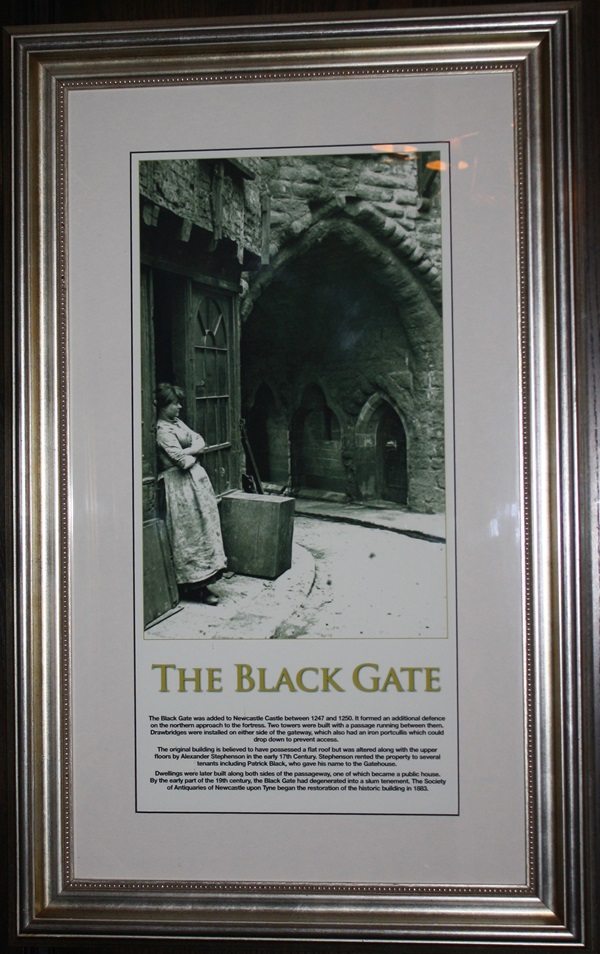
The text reads: The Black Gate was added to Newcastle Castle between 1247 and 1250. It formed an additional defence on the northern approach to the fortress. Two towers were built with a passage running between them. Drawbridges were installed on either side of the gateway, which also has an iron portcullis which could drop down to prevent access.
The original building is believed to have possessed a flat roof but was altered along with the upper floors by Alexander Stephenson in the early 17th Century. Stephenson rented the property to several tenants including Patrick Black, who gave his name to the Gatehouse.
Dwellings were later built along both sides of the passageway, one of which became a public house. By the early part of the 19th century, the Black Gate had degenerated into a slum tenement. The Society of Antiquaries of Newcastle upon Tyne began the restoration of the historic building in 1883.
Photographs and text about Hank Marvin.
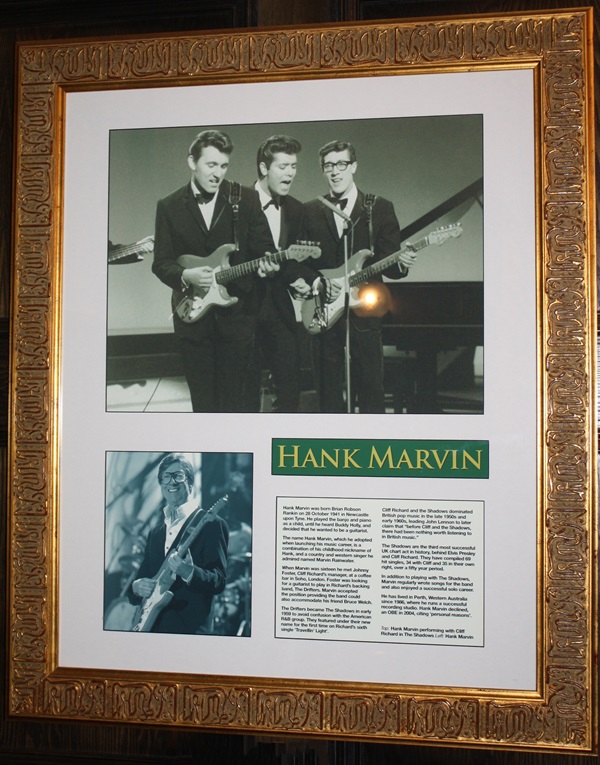
The text reads: Hank Marvin was born Brian Robson Rankin on 28 October 1941 in Newcastle upon Tyne. He played the banjo and piano as a child, until he heard Buddy Holly, and decided that he wanted to be a guitarist.
The name Hank Marvin, which he adopted when launching his music career, is a combination of his childhood nickname of Hank, and a country and western signer he admired named Marvin Rainwater.
When Marvin was sixteen he met Johnny Foster, Cliff Richard’s manager, at a coffee bar in Soho, London. Foster was looking for a guitarist to play in Richard’s backing band, The Drifters. Marvin accepted the position providing the band could also accommodate his friend Bruce Welch.
The Drifters became The Shadows in early 1959 to avoid confusion with the American R&B group. They featured under their new name for the first time on Richard’s sixth single ‘Travellin’ Light’.
Cliff Richard and the Shadows dominated British pop music in the late 1950s and early 1960s, leading John Lennon to later claim that “before Cliff and the Shadows, there has been nothing worth listening to in British music.”
The Shadows are the third most successful UK chart act in history, behind Elvis Presley and Cliff Richard. They have compiled 69 hit singles, 34 with Cliff and 35 in their own right, over fifty year period.
In addition to playing with the Shadows, Marvin regularly wrote songs for the band and also enjoyed a successful solo career.
He has lived in Perth, Western Australia since 1986, where he runs a successful recording studio. Hank Marvin declined an OBE in 2004, citing ‘personal reasons’.
Top: Hank Marvin performing with Cliff Richard in the Shadows
Left: Hank Marvin.
External photograph of the building – main entrance.
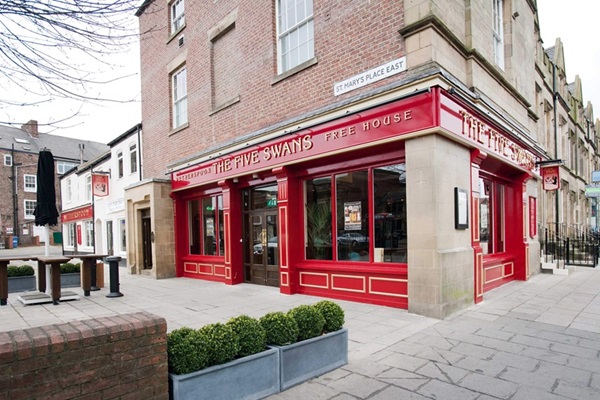
If you have information on the history of this pub, then we’d like you to share it with us. Please e-mail all information to: pubhistories@jdwetherspoon.co.uk